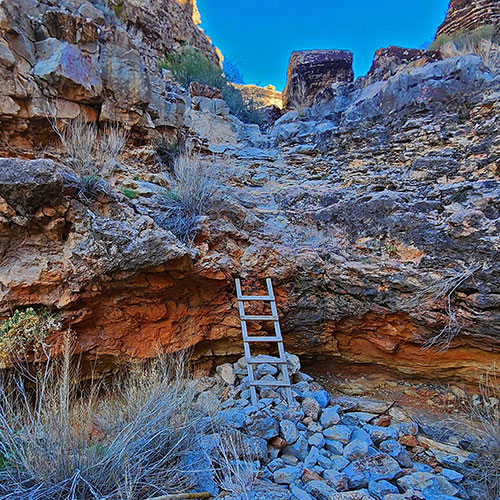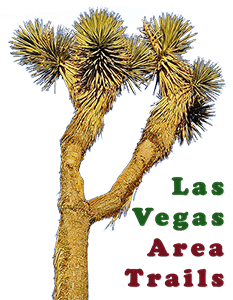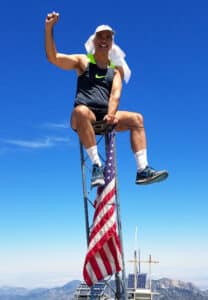Immerse yourself in two huge wild canyons just 5 minutes from Metro Las Vegas. Fossil Canyon and Cowboy Canyon are located in the Northern Blue Diamond Hill area. As you explore these canyons you will experience:
There are defined, but unmarked trails along Fossil Ridge and in Fossil Canyon. However, once you emerge above upper Fossil Canyon and make your way over to Cowboy Canyon you’ll be faced with a network of “rabbit trails”. As you descend Cowboy Canyon from above you’ll seldom see brief paths. But navigation is not difficult. Just descend the canyon floor between the towering cliffs on either side.
The best time is mid-to-late Fall through mid-to-late Spring. Summer temperatures can easily exceed the upper 90’s. The area is snow and ice-free throughout the year except for a brief time following heavy precipitation with temperatures below 35 degrees in Las Vegas.
Take the Charleston Blvd. exit off Hwy 215 in Las Vegas. Head up toward the mountains (Red Rock Canyon). You’ll pass Calico Basin and then the Red Rock Canyon entrance. Just a bit beyond that watch for the Cowboy Trail Rides on the left.
Park in the Fossil Canyon Trailhead area on the South (left) side of Highway 159 outside the Cowboy Trail Rides operation.
From the Fossil Canyon Trailhead Parking Area on Highway 159 (Cowboy Trail Rides entrance), cross under the Horseback Riding sign and take the second trail on the right. This will lead you to Fossil Ridge. Notice a gray route on the map. This was my mistaken route when I took the first trail on the right. This created a wider circuit to Fossil Ridge, but I still ended up on the ridge. You’ll see this in the video. That’s an important learning about the Blue Diamond Hill area. The surrounding landmarks are so clear, once you’re familiar with them, that you can’t get lost. And going off-track, then finding your way back on course can be a fun journey of discovery!
So, I noticed a line of horseback riders ascending a ridge to the East and immediately recognized, “That’s Fossil Ridge”! It was easy to navigate back to the Fossil Ridge Trail which I reached just below the split into Fossil Canyon. By the way, during an earlier adventure I discovered far more fossils on Fossil Ridge than in Fossil Canyon.
The main benefit of Fossil Canyon was not the fossils, but the beautiful sculpted rock formations along the right (West) side of the canyon. The Fossil Canyon Trail traverses the West side of the canyon between the upper rim and the canyon base. The trail is very well-defined. Another great benefit is the spectacular framed view of Red Rock Canyon which expands more and more as you ascend Fossil Canyon. So remember to turn around often. I noticed a very faint trail through the base of Fossil Canyon. That could be a future cool path of discovery.
Once you reach the upper end of the Fossil Canyon Trail, you emerge into quite a confused network of small unmarked paths. My strategy was to take a left and make a wide circuit over to upper Cowboy Canyon. I stuck to an adjoining upper canyon, which had a very beautiful and untouched terrain (see the video on this page).
Good reference points along the way are to recognize First Finger and Second Finger. These are peninsula ridges jutting out above to your left and reaching down Blue Diamond Hill. First Finger is along the East side of upper Fossil Ridge. Second Finger is along the West side of Cowboy Canyon. See the map on the Blue Diamond Hill Overview Page. There are trails that loop down and around the outer edge of First and Second Fingers. That’s another adventure. In this case, you’re circling around the upper end of First and Second Finger and then down into upper Cowboy Canyon.
As you pass Second Finger, navigate your way to the base of upper Cowboy Canyon. You can’t miss this canyon due to the high cliff walls on either side. These cliff walls present the awesome views described above. Curiously, upper Cowboy Canyon is far easier to navigate than lower Cowboy Canyon, which has a surface of huge boulders. On the other hand, upper Cowboy Canyon has a mostly of wide, gravel wash surface with a gradual incline of descent. There are a few rocky areas to scramble to lower levels, but these are so tame that I rarely needed to use my hands. Always scanning the cliff walls above for caves, I did discover one opening that looked easy enough to approach. It turned out to be a shallow opening, but still a cave.
The dividing point I identify between upper and lower Cowboy Canyon is the ledge and ladder just below the popular Cowboy Caves. Everything above is upper Cowboy Canyon, below is lower Cowboy Canyon. Once you reach the caves and the ledge, you’re back in a popular hiking area and are bound to see the first humans you’ve seen since entering upper Cowboy Canyon.
There are three main Cowboy Caves: Two above the ledge and ladder; one below the ledge and ladder. I did not explore the caves on this day, but will return to do so. The two upper caves are located on the Western cliff wall. I understand the upper cave is the largest and goes upward through the limestone all the way to the ridge above. I have not personally verified this. The lower cave is also significant but not as large.
The cave below the ledge and ladder is on the left (Eastern) wall of Cowboy Canyon. It’s almost immediately below the ledge, to your left (as you’re descending the canyon). I understand this cave has a bat population, but have not yet verified it myself.
Reports of that ledge and ladder caused me to envision a big bad terrible obstacle. It turned out to be rather tame. First of all, descending Cowboy Canyon and having never been on that ledge, it was pretty unnerving to descend the upper part of the ledge, right over to the very edge, before seeing the ladder for the first time! It was an act of faith, believing the ladder would be there. I expected a tall, 30-50ft rickety wooden ladder. To my surprise, when I actually looked over the edge to the ladder, it was only 5 steps! Yes, working my way over the edge to where the ladder began below was a bit scary. I was told it would help to turn around and face the cliff as you descended the ladder. I couldn’t get myself to turn around, so went down the ladder facing outward. Not a real problem. Just carefully plant each hand and foothold. And, it’s not a huge drop…only five steps! The whole experience was tame, and if I had to do it over again, it would be a walk in the park.
As I was pleasantly surprised by that tame ledge and ladder, I was surprised by how difficult it was to navigate lower Cowboy Canyon! There were huge boulders and ledges in the mid-section. Having come from above and never having ascended this stretch, it was a adventure of discovery. Alternately I looked over the edge of ledges with vertical drop-offs mid-canyon, then searched out bypass routes along the right and left sides. Fortunately, there was always a bypass route…just be patient and observant. Hindsight says that had I stuck to the West (left) canyon wall during the descent, I would have found something resembling a trail and the going would have been much quicker and far less complicated. But this was a journey of discovery!
The boulder section eventually ends and a nice trail appears that will take you down to the upper Cowboy Rides corral. There, you can walk on the road past the main building, along the corral and finally back down to the Fossil Canyon Trailhead where you began this adventure. I had been a little worried that walking on the road along the upper corrals would be trespassing private property, but it’s all open and hikers are free to pass through that area.
Traversing Fossil Canyon and the entire length of Cowboy Canyon is hugely rewarding. As mentioned above, you may feel as though you are in a far-away wild, remote wilderness area full of spectacular views and many cool discoveries. However, remember, this deeply spiritual, entire day of wilderness immersion is only 5 minutes from the edge of metro Las Vegas! Enjoy!



Return often to experience one new adventure each week! From the home page scroll to “Most Recent Adventures“. More about David Smith…
The trail adventures on this website require proper conditioning, preparation and safety precautions. There are many factors beyond our control including weather conditions, unstable ground, loose rocks, insects and snakes, people you may encounter, your own level of physical conditioning, the potential of getting lost just to mention a few. While this site offers guidance, helpful tips, direction and training, the reader assumes full responsibility for whatever may occur during their trail adventure. Have fun and be safe!